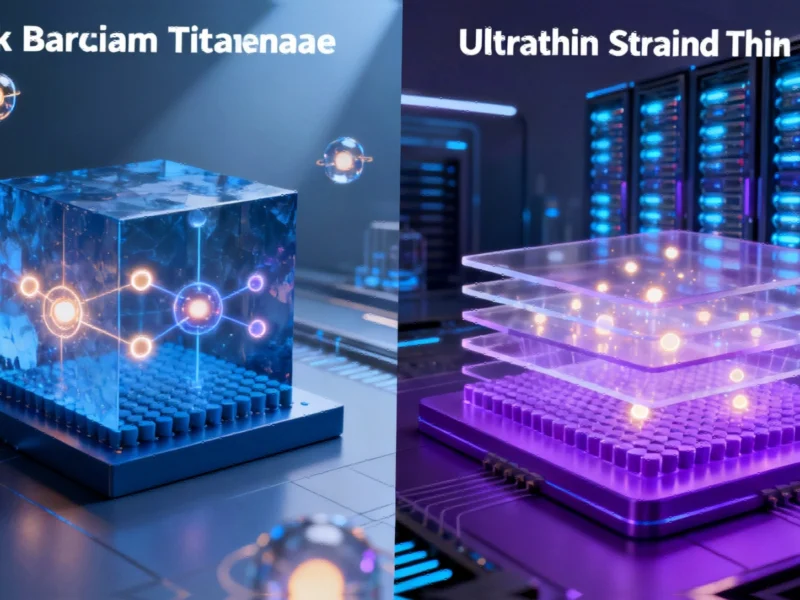Reviving a Classic Material for Next-Generation Computing
A groundbreaking approach to manipulating barium titanate—a material discovered over eight decades ago—could simultaneously advance quantum computing networks and dramatically reduce energy consumption in data centers. Researchers at Penn State have demonstrated that creating ultrathin, strained films of this classic material produces exceptional electro-optic properties that surpass previous limitations. This development represents a significant step toward revolutionizing quantum information systems while addressing the massive energy demands of modern computing infrastructure.
Barium titanate, first identified in 1941, has long been recognized for its superior electro-optic capabilities in bulk crystal form. These materials serve as critical interfaces between electrical and optical systems, converting electron-based signals into photon-based information. Despite its theoretical advantages, the material never achieved widespread commercial adoption due to stability and fabrication challenges, with lithium niobate becoming the industry standard despite its inferior performance characteristics.
Engineering Matter at the Nanoscale
The Penn State team’s innovation lies in restructuring barium titanate into films approximately 40 nanometers thick—thousands of times thinner than a human hair. By growing these films on another crystal substrate, researchers forced the material’s atoms into new configurations, creating what scientists call a metastable phase. This engineered crystal structure doesn’t occur naturally but exhibits properties that the stable form cannot achieve.
“Metastable phases can have properties the stable version may not,” explained Venkat Gopalan, Penn State professor of materials science and engineering and study co-author. “In this case, the stable phase of barium titanate loses much of its electro-optic performance at low temperatures, which is a big problem for quantum applications requiring superconducting qubits. But the metastable phase we created not only avoided that drop, it also showed a response that was exceptional.”
Quantum Networking Breakthrough
The strained barium titanate films demonstrated more than ten times improvement in electron-to-photon conversion efficiency compared to previous demonstrations at cryogenic temperatures. This enhancement addresses one of the most significant challenges in quantum computing: transmitting information between quantum computers. Current systems rely on microwave signals that degrade quickly over distance, limiting the development of distributed quantum networks.
“Microwave signals work for qubits on a chip, but they are terrible for long-distance transmission,” said Albert Suceava, co-lead author and doctoral candidate in materials science and engineering. “To go from individual quantum computers to quantum networks spread over multiple computers, information needs to be converted into a kind of light that we’re already very good at sending long distances, such as the infrared light used for fiber optic internet.”
This advancement in quantum information transmission builds upon fundamental quantum principles that challenge conventional physical laws, opening new possibilities for information processing.
Transforming Data Center Efficiency
Beyond quantum applications, the improved electro-optic conversion efficiency holds tremendous potential for conventional data centers that power everything from artificial intelligence to cloud services. These facilities consume enormous amounts of electricity, with significant portions dedicated to cooling systems that manage heat generated by electronic components.
“Integrated photonic technologies as a whole are becoming increasingly attractive to companies that use large data centers to process and communicate large data volumes, especially with the accelerating adoption of AI tools,” said Aiden Ross, co-lead author and graduate research assistant at Penn State. “The basic idea is that we could send information throughout these centers using photons rather than electrons, letting us send many streams of information in parallel, and do so without having to worry about our electronics heating up.”
Because photons generate minimal heat compared to moving electrons through wires, optical interconnects could dramatically reduce both energy consumption and cooling requirements. This approach to energy efficiency represents a crucial advancement as computational demands continue to escalate across industries.
The Science of Metastability
The researchers compared their metastable material design to holding a ball on a hillside. Under normal circumstances, the ball would roll to the bottom—representing the lowest energy state that materials naturally seek. By carefully engineering the crystal structure, the team essentially “cradled the ball” in a higher energy configuration that enables exceptional performance characteristics.
This fundamental materials science breakthrough demonstrates how unexpected discoveries in material behavior can lead to transformative technological applications, much like recent findings in planetary science have challenged established understanding.
Broader Implications and Future Directions
The research team believes their approach to material design extends well beyond barium titanate. The strategy of creating metastable phases through strain engineering could unlock superior properties in various material systems that have previously been overlooked or underutilized.
“Achieving this result with barium titanate was a case of taking a new material design approach to a very classic and well-studied material system,” Gopalan said. “Now that we understand this design strategy better, we have some less well-studied material systems that we want to apply this same approach to. We are very optimistic that some of these systems will exceed even the incredible performance that came out of barium titanate.”
As computational systems continue to evolve, the intersection of materials science, quantum computing, and energy efficiency becomes increasingly critical. This research demonstrates how revisiting classic materials with modern nanoscale engineering techniques can yield breakthroughs with far-reaching implications for both quantum technologies and conventional computing infrastructure. The development of more efficient photonic systems also highlights the importance of addressing fundamental system vulnerabilities as we build the computational infrastructure of the future.
Based on reporting by {‘uri’: ‘phys.org’, ‘dataType’: ‘news’, ‘title’: ‘Phys.org’, ‘description’: ‘Phys.org internet news portal provides the latest news on science including: Physics, Space Science, Earth Science, Health and Medicine’, ‘location’: {‘type’: ‘place’, ‘geoNamesId’: ‘3042237’, ‘label’: {‘eng’: ‘Douglas, Isle of Man’}, ‘population’: 26218, ‘lat’: 54.15, ‘long’: -4.48333, ‘country’: {‘type’: ‘country’, ‘geoNamesId’: ‘3042225’, ‘label’: {‘eng’: ‘Isle of Man’}, ‘population’: 75049, ‘lat’: 54.25, ‘long’: -4.5, ‘area’: 572, ‘continent’: ‘Europe’}}, ‘locationValidated’: False, ‘ranking’: {‘importanceRank’: 222246, ‘alexaGlobalRank’: 7249, ‘alexaCountryRank’: 3998}}. This article aggregates information from publicly available sources. All trademarks and copyrights belong to their respective owners.



